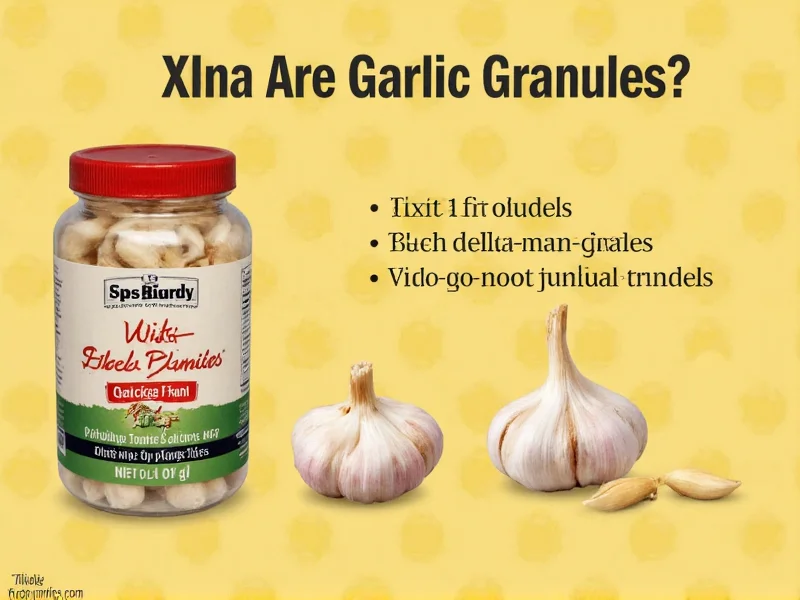Understanding Garlic Granules: Texture, Production, and Composition
Garlic granules begin as fresh garlic bulbs that undergo a careful dehydration process. Manufacturers slice peeled garlic cloves into small pieces before drying them at controlled temperatures (typically 140-160°F) to preserve maximum flavor compounds. The dried garlic then passes through specialized mills that create uniform granules measuring 0.5-2 millimeters—significantly larger than the fine particles of garlic powder (which measures under 0.5mm).
This specific texture creates distinct culinary advantages. The larger surface area compared to powder allows for slower dissolution in liquids, preventing immediate flavor dominance in dishes. Food scientists note that granules maintain approximately 85% of fresh garlic's allicin potential when stored properly, versus 70-75% in standard garlic powder due to increased oxidation from finer particles.
Garlic Granules vs. Powder vs. Fresh: A Practical Comparison
| Characteristic | Garlic Granules | Garlic Powder | Fresh Garlic |
|---|---|---|---|
| Particle Size | 0.5-2mm (coarse sand) | Under 0.5mm (fine powder) | N/A (minced: 1-3mm) |
| Flavor Release | Moderate (5-10 minutes) | Immediate (1-2 minutes) | Immediate (varies by preparation) |
| Shelf Life | 2-3 years (proper storage) | 1-2 years | 1-2 months (bulb) |
| Allicin Preservation | High (85% potential) | Moderate (70-75%) | Very High (100% when fresh) |
| Best Culinary Uses | Dry rubs, slow-cooked dishes, marinades | Sauces, dressings, quick-cooking recipes | Raw applications, quick sautés |
Culinary Applications and Flavor Dynamics
Chefs prefer garlic granules for specific applications where controlled flavor release matters. When making dry spice rubs for meats, the granules adhere better to surfaces than powder while providing more consistent flavor distribution than fresh garlic pieces. In slow-cooked dishes like stews or braises, granules gradually infuse flavor over hours without becoming bitter—a common issue with garlic powder in prolonged cooking.
Understanding how to use garlic granules in cooking requires recognizing their rehydration properties. Unlike powder that dissolves instantly, granules need 5-10 minutes in liquid to fully release flavor. This makes them ideal for recipes where you want garlic flavor to develop gradually. For immediate garlic impact, briefly toast granules in oil before adding liquids—a technique that activates flavor compounds while preventing raw bitterness.
Nutritional Profile and Health Considerations
Nutritionally, garlic granules retain most of fresh garlic's beneficial compounds when properly processed. A teaspoon (2.8g) contains approximately:
- 9 calories
- 0.2g protein
- 2.1g carbohydrates
- 0.1g fiber
- 1.7mg allicin potential (when rehydrated)
- Trace minerals including selenium and manganese
Research published in the Journal of Agricultural and Food Chemistry confirms that dehydrated garlic forms maintain stable antioxidant levels when stored away from light and moisture. However, the health benefits of garlic granules diminish significantly when exposed to high heat for extended periods—another reason why they work best in dishes with moderate cooking temperatures.
Practical Usage Guidelines for Home Cooks
When substituting garlic granules in recipes, use this conversion guide:
- 1 clove fresh garlic = 1/4 teaspoon garlic granules
- 1 teaspoon garlic granules = 1.5 teaspoons garlic powder (adjust liquid content)
- For roasted garlic flavor: Use 1/2 teaspoon granules + 1/8 teaspoon onion powder
Many home cooks wonder can you substitute garlic granules for fresh garlic—the answer is yes, but with timing considerations. Add granules early in cooking for infused flavor, or during the last 10 minutes for more pronounced garlic notes. Unlike fresh garlic, granules won't burn when sautéed alone, making them forgiving for novice cooks.
Optimal Storage Practices for Maximum Freshness
To maintain flavor and nutritional value, store garlic granules in airtight containers away from light and moisture. The ideal conditions include:
- Ambient temperature below 70°F (21°C)
- Relative humidity under 60%
- Opaque containers (glass or metal preferred over plastic)
Properly stored, garlic granules maintain peak quality for 24-36 months. Signs of degradation include clumping, darkening color, or diminished aroma. Never store near heat sources like stoves, as temperature fluctuations accelerate flavor compound breakdown. For extended storage, consider dividing bulk purchases into smaller portions to minimize air exposure each time you access the main supply.











 浙公网安备
33010002000092号
浙公网安备
33010002000092号 浙B2-20120091-4
浙B2-20120091-4